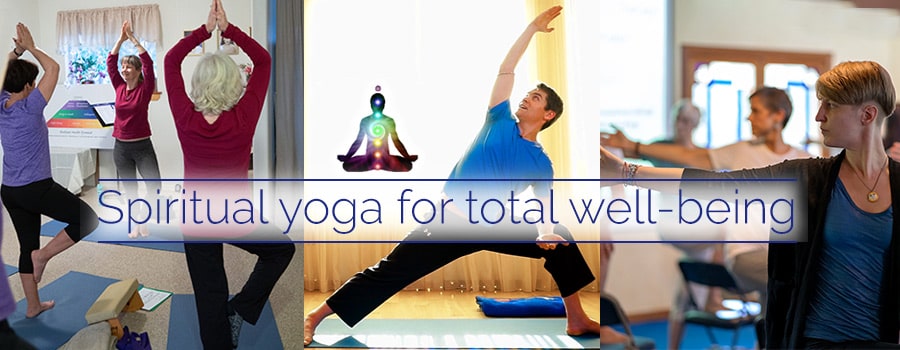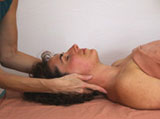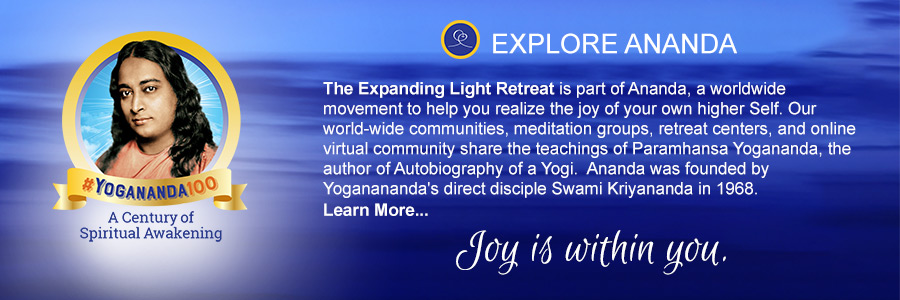Overcoming Insomnia and Inertia
by Gyandev Rich McCord, PhD
Expanded version of a talk given at SYTAR 2007 in Los Angeles. (Download a PDF of the article.)
I am going to share with you some of my experience in using Yoga techniques therapeutically to help people with insomnia. I developed this approach in conjunction with Dr. Peter Van Houten, director of Sierra Family Medical Clinic near Ananda Village in Northern California, where Dr. Van Houten and I live, and where I do much of my teaching at The Expanding Light retreat. Dr. Together we have authored two books: Yoga Therapy for Overcoming Insomnia and Yoga Therapy for Headache Relief.
Our approach is based on Ananda Yoga®, a classical style of Hatha Yoga that evolved out of the teachings of Paramhansa Yogananda (author of Autobiography of a Yogi). Ananda Yoga was developed by Swami Kriyananda (founder of Ananda), a direct disciple of Yoganandaji’s.
Insomnia – A Modern Epidemic
It is our feeling that the area of insomnia holds special potential for Yoga therapy to be effective, and our experience so far has certainly borne this out.
The need for an effective approach is great. The problem of insomnia has reached alarming proportions with massive consequences. According to a National Sleep Foundation poll, over half of all adults in the United States experience symptoms of insomnia at least 2 – 3 times per week. This leads not only to a diminished quality of life, but also to huge losses in productivity and increased healthcare costs due to accidents in and out of the workplace.
As in almost all Yoga therapy, a therapeutic approach to insomnia must be tailored to the needs of each individual. However, this is especially true for insomnia because it has so many different causes, some of which include:
- Illness
- Injury
- Side effects of medications
- Menopause
- Stress (from overwork or from emotional challenges)
- Preoccupation with people, projects, etc.
- Health conditions with proven correlations with insomnia – e.g., anxiety, depression, obesity, diabetes, high blood pressure (Note: Causal relationships between insomnia and these conditions have not yet been fully delineated.)
- Lifestyle habits
- Attitudes toward sleep
- Unknown causes
Conventional treatment of insomnia most commonly calls for medications. Other approaches include natural supplements (e.g., melatonin, magnesium, tryptophan, vitamins), lifestyle changes, and behavioral therapy (e.g., relaxation techniques). Although each of these has its place, Yoga therapy adds a unique therapeutic dimension.
Because of the extreme diversity of causes of insomnia, I will present here only the general framework of our approach. Also, much of what I say also applies to other arenas of Yoga therapy, but I will stay specific to insomnia.
Our approach has three basic components: background inquiry, therapeutic routine, and client motivation.
Background Inquiry
In any Yoga therapy, it is important to begin by exploring with the client the nature of the problem. Here I will address four main aspects of this issue.
The Insomnia Itself
I first ask the client to describe how the insomnia presents, which will be one or more of the following:
- Difficulty getting to sleep
- Waking up during the night, and having difficulty getting back to sleep
- Waking frequently through the night
- Sleeping more or less through the night, but not feeling refreshed upon awakening in the morning (i.e., poor quality of sleep)
I also ask whether a cause of the insomnia has been determined. Most often, the people who come to me do not know the cause of their insomnia, but sometimes they do, and that can help focus a therapeutic program.
I’ll next ask whether they experience specific physical sensations that make sleep more difficult. Bodily tensions and agitation are perhaps the most common examples of this. An extreme example of this is Restless Legs Syndrome, in which a person begins to experience some form of agitation in the legs whenever coming to rest, and especially when lying down for sleep. (Severe RLS usually requires medication, but Yoga therapy can sometimes reduce its severity.) Knowing about sleep-disturbing sensations can guide me to offer specific physical movements or asanas that help reduce or eliminate those sensations.
I also explore with the client any correlations there may be between sleep difficulties (or lack thereof) and things that have or have not been done or experienced during the preceding day, including foods that have or have not been eaten. This can be an important clue to the nature of the insomnia, and it’s often an area that the client has not examined thoroughly.
Finally, I’ll ask whether any related conditions have been diagnosed, such as those mentioned earlier: anxiety, depression, obesity, diabetes, or high blood pressure. I’ll also want to know about medications the client is taking (for these or for other conditions), since side effects of medication often impact sleep.
Lifestyle Issues
Certain aspects of lifestyle can play a very large part in insomnia. Some people unknowingly exacerbate – or even cause – their insomnia through their daily activities. It’s important to consider these because Yoga therapy tends to be subtle enough that some sleep-unfriendly practices can completely overpower its ability to help. On the other hand, proper attention to lifestyle issues is sometimes all that’s needed to diminish, or even eliminate, insomnia.
Here are a few practices that can improve the quality of sleep for many people:
- Have a regular bedtime and a regular rising time, which help condition the body and mind to sleep or awaken at the chosen time.
- Exercise regularly, ending at least 3 hours before bedtime.
- Avoid caffeine, alcohol and nicotine, which have been shown to adversely affect sleep, especially when consumed near bedtime.
- Avoid daytime naps.
- Keep dinner relatively light, and eat it well before bedtime
- Pursue only calming activities near bedtime. Especially treat the last hour before bedtime as sacred time: no late-night TV, computer work, agitation or competition. Instead, read a relaxing book, listen to relaxing music, connect meaningfully with your spouse, or meditate.
- Create a sleep-conducive bedroom. It should be dark and quiet, and it may be helpful to keep the room cool. Equally important, don’t use the bedroom for work or TV. A room acquires the vibration of that which happens there, and if you work in your bedroom, it will likely be more difficult to sleep. Reserve the bedroom for sleep and sex only.
Here’s a common example: I recently worked with a woman who had a very busy, stressful job. She felt she didn’t have time for an actual lunch break, so she would simply eat a protein bar as she worked through lunch. She also worked late, and by the time she came home, she was usually famished, so a latish dinner was her largest meal of that day. And she wondered why she didn’t sleep well! Her program needed to begin, not just with asanas or other techniques, but with taking a real lunch break during which she ate real food!
Attitudes about Sleep
When I first began working with people with insomnia, I didn’t realize that some people actually have sleep-antagonistic attitudes – not consciously, perhaps, but the attitude can be there nevertheless.
For example, I recently worked with a woman who, when younger, had been going to school part-time, working full-time, and raising children. This made for a brutal schedule, so something had to go. Work couldn’t go because the family needed the income. School couldn’t go because she wanted a better job. And certainly the children couldn’t go. The only option seemed to be to sleep less, so with a strong will she began to live on just 2 – 3 hours of sleep per night. Through a combination of youthful vigor, strong willpower, and sheer necessity, she was able to make this pattern work for quite some time. Years later, however, when school was long since ended and her kids were grown, she was still in the habit of sleeping just 2 – 3 hours per night, even though her body and mind were now crying out for more sleep. She was exhausted and becoming less and less functional; she simply couldn’t let go of the years of habit. By the time she came to me, this had been going on for 31 years!
There are other sleep-antagonistic attitudes as well, such as “I shouldn’t need much sleep,” “Sleep is a time spent unproductively,” and “I am a person who cannot sleep.” Held over a period of time, any of these attitudes will become rooted in the subconscious mind and serve as a powerful deterrent to better sleep. Thus it becomes important to discover whether the client has traces of such attitudes. Since the client may not hold such an attitude consciously, it can take some questioning to ferret out the information, but it can be very helpful to do so.
Attitudes about Yoga Therapy
My earliest clients were already interested in Yoga, at least a little bit. So of course they were usually open to – even enthusiastic about – a yogic approach to insomnia. It wasn’t until I began working with Dr. Van Houten and became aware of the patients at his rural clinic – many of whom would never think to practice Yoga except at his suggestion – that I realized I had to understand and take into account their willingness and readiness to practice Yoga techniques. If they weren’t highly motivated in this area already, they often wouldn’t be willing to do much with Yoga. And even if they were, they might not be able to relate to (and therefore practice effectively) some of the Yoga techniques. I realized that such considerations would have to shape the therapeutic routines I developed.
The Therapeutic Routine
When a person is not sleeping well, some level of his or her being – body, subtle energy, mind – is out of harmony with the sleep state. If it were otherwise, sleep would be easy. It doesn’t matter whether the cause is at the level of the mind, or energy, or body; almost invariably it will migrate to the other levels as well, causing them, too, to be out of harmony with sleep. A therapeutic routine must try to bring all these levels into harmony with the sleep state.
What does that mean? At the level of the body, it means relaxation and ease. At the energy level, it means that the subtle energy is flowing smoothly, calmly, and freely. At the level of the mind, there is a sense of releasing, letting go, giving oneself to the sleep state. To ignore any of these levels is to invite the unwelcome guest of insomnia to stay a bit longer.
Our therapeutic routines are intended for practice just before bedtime, for if the routine can succeed in harmonizing body, energy and mind with sleep, then going to sleep will be the most natural conclusion to the practice. Besides, since the routine is intended to take a person into sleep, practicing at other times of the day would increase the appeal of daytime naps, which are known to create nighttime sleep difficulties for some people.
There’s also a subtler reason for doing the routine at bedtime: If the routine works well, the fact that it happens right before bed will make it clearer to the client that the routine is having an impact. This strengthens the client’s trust in the routine, which in turn motivates him or her to do the practice, which in turn leads to better results.
The basic routine includes at least two of the following three common-sense phases: the Take Charge Phase, the Calming Phase, and the Finishing Phase.
Take Charge Phase
One might think that relaxation is the place to start, and for many people, that’s true. But it’s not true for people who are agitated or “wired” at bedtime, because the leap from “wired” to “calm” can be so great that they may not be able to relate well to calming practices. Such practices might even make them more agitated. These people need a preliminary phase that’s a bit more active in order to take charge of the body, energy and mind.
This Take Charge Phase is short, and it will include asanas, breathing techniques and/or tensing/relaxing techniques that are slightly activating. They’ll usually be done only briefly, to gain control of body, energy and mind rather than stimulate them. There won’t be many such techniques in a therapeutic routine for insomnia, because we don’t want stimulation; usually just one or two will suffice.
Here’s an example of a simple, effective take-charge technique taught by my guru, Paramhansa Yogananda. It’s called Double Breathing with Tension/Relaxation. The Double Breath is a short inhalation, followed by a long inhalation, through the nose: sniff sniiiiiif. There follows a short exhalation, followed by a long exhalation, through both nose and mouth: ha haaaaaa. (Don’t vocalize the sound; the only sound is air passing through the nose and mouth.) The full technique is to take a full Double Inhalation, then hold the breath and tense the entire body, and then relax the body with a Double Exhalation. If you do this with strong Double Breathing and high tension in the body (so high that the body vibrates with energy), the technique will be both relaxing and energizing. That makes it an excellent technique to use during the day, but it’s usually not what is needed for sleep. Instead, we take a moderate-sized Double Breath, and use only light tension – just enough to take charge of body, energy and mind, without stimulating them unduly.
Here’s another very simple example: the Full Yogic Breath. For a real “take charge” effect, it’s best to do this standing rather than sitting. As you inhale smoothly, first feel the abdomen expanding, then the lower rib cage, then the chest as you finish the inhalation. The exhalation is just the reverse: the chest relaxes in, then the lower ribs, then the abdomen. This technique may take a bit of concentration at first, but it comes quickly with practice. If you take strong Fully Yogic Breaths, it will be both relaxing and energizing; again, that’s not what we want for insomnia, so the breath should be moderate and the expansion/relaxation should not be exaggerated.
Other effective take-charge techniques could be simple asanas that, when practiced normally, are quite energizing: e.g., Ardha Chandrasana, Virabhadrasana I. For insomnia, however, we would hold the asana just for a breath or two, to take charge without being overstimulated. Then one is ready for the Calming Phase.
Calming Phase
For people who are not “wired,” this is the first phase of their therapeutic routine. It consists mostly of what any yoga teacher would recommend for insomnia: calming techniques. It includes asanas that are known to be calming, such as forward bends, gentle twists, and simple inverted poses.
As we know, however, any Hatha Yoga routine needs to be balanced. For example, if there is a forward bend, there should be backward bend as well, lest the practice end with the client not feeling “centered” on some level. Besides, sometimes a backward bend is the best way to relieve tension and restlessness in certain parts of the body, such as the chest. Yet backward bends are usually considered stimulating. Are they therefore ruled out for an anti-insomnia practice?
Not at all. The key is to practice such poses in a calming, relaxing way. Clearly we’re not talking about Chakrasana (Wheel Pose) or similar stimulating asanas, but others are certainly possible. Prominent among them is Supta Vajrasana (Supine Firm Pose), which is excellent for releasing the “get up and go” energy in the legs that is chronic in many people. (Imagine sitting at home in a chair, reading, and suddenly realizing that you’re hungry and remembering that you have something particularly tasty in the kitchen. You haven’t even decided to go get it; you’ve simply realized that you could go get it. Often, the mere thought of this possibility will cause muscles in the fronts of the legs and/or abdomen to contract in anticipation of movement. Now imagine being a person in whom this is happening all day long, as a frantic urge to act keeps these muscles engaging almost nonstop. Are the muscles suddenly going to relax completely just because the person has decided it’s bedtime? Not likely!)
The “normal” version of Supta Vajrasana can be rather challenging for the knees, thighs and, if one is not careful, lower back. Doing the pose that way, however, will not be sleep-friendly for most people; quite the contrary, the sympathetic nervous system may kick into survival mode! So I work with the client to modify Supta Vajrasana to make it not merely comfortable, but relaxing. We’ll often do the pose with a stack of cushions under the shoulders and head, or sitting on a chair, or even on two chairs plus a stack of cushions. Done this way, Supta Vajrasana can be extremely pleasant and relaxing as it releases the legs’ get-up-and-go energy. (See Yoga Therapy for Overcoming Insomnia for detailed descriptions and photos of these modifications.) Interestingly, this effect is sometimes harder to achieve with practicing yogis than with newcomers, because experienced practitioners can be very goal-oriented and wind up doing this pose in such a way that is stimulating, not relaxing.
In fact, all the asanas – not just backward bends – should be practiced with relaxation and ease. This means, for one thing, diaphragmatic breathing throughout the asana practice. (A more accurate term might be abdominal breathing or belly breathing, since in fact all breathing employs the diaphragm.) And just as important as the asanas themselves is the way one enters and exits the asanas. These movements must be graceful, conscious, slow and calm in order for the practice to yield fruit. If the entries and exits are not done this way, the practice could deter sleep rather than facilitate it.
I’ll sometimes ask the client to end the Calming Phase with a calming pranayama technique while sitting on the edge of the bed, with lights out, ready to swing into bed and sleep. One excellent such technique is 1:2 (One-to-Two) Breathing, in which the exhalation is twice as long as the inhalation (within the bounds of the client’s comfort).
Finishing Phase
Having calmed the body and breath, we then use a specialized deep relaxation in Savasana – lying in bed with lights out – to go directly to sleep. There are many such techniques to choose from, and most people like to choose one to use all the time. Examples of these techniques are
- Simple Breathing Practices – e.g., Abdominal Breathing or 1:2 Breathing
- Progressive Relaxation – moving up the body, from the feet to the head, relaxing each part in turn, with or without tension/relaxation or breath coordination
- Specialized Visualization – using the power of all-senses visualization to create an inner atmosphere of peace, safety and letting go
- Affirmation – silent affirmation to harmonize the mind completely with the sleep state, and perhaps to counter directly any subconscious anti-sleep attitudes
The finishing techniques are done with eyes closed and turned downward, which is their normal position for sleep. This small point was another adjustment for me, as most of my usual teaching focuses on raising the consciousness to the superconscious level, which is best facilitated by turning the eyes gently upward. In teaching meditation, for example, I must constantly remind people not to let their eyes drop, which can invite subconsciousness and sleep. How ironic that now, for insomnia, I encourage people to turn their eyes downward!
These finishing techniques are described in detail in Yoga Therapy for Overcoming Insomnia. I have also made a CD called Ease into Sleep, in which they are guided and taught. See the end of this article for more information.
By the way, for people whose primary sleep difficulty is middle-of-the-night awakening, these finishing techniques are the place I usually have them begin. There’s a more thorough discussion of this particular manifestation of insomnia in Yoga Therapy for Overcoming Insomnia.
Is It Really Yoga?
So far, most of what I’ve written about is just exercise and breathing. So is it Yoga therapy? Not really, not yet; there needs to be another component. To achieve anything in Yoga – from the traditional, sublime goal of higher awareness, to the mundane goal of going to sleep – one must actively cooperate with the techniques. This means putting the mind – and more important, one’s feeling nature – into harmony with the goal one seeks. To some degree that will happen automatically via the other techniques, but the Yoga techniques are not sleeping pills, to be taken and then forgotten about! Yoga is, above all, about consciousness, and the consciousness we seek should be practiced within all the techniques we use to try to achieve it.
How does this come into play in insomnia? It’s about bringing the mind deliberately into a state of relaxation, of release, of letting go. The asanas and other techniques should be practiced with that attitude. Better still is to add the classical Yoga technique of affirmation, which also happens to be an evidence-based part of a well-accepted branch of modern healthcare: Cognitive Behavioral Therapy (CBT). (Dr. Van Houten sometimes jokes: “I can’t bill the insurance company for prescribing affirmations, but I can bill for CBT!”)
This is a particularly natural practice for an Ananda Yoga-therapeutic approach to insomnia, because one of the hallmarks of Ananda Yoga is that each asana has its own affirmation, designed to help one harmonize the mind with the direction of consciousness that the asana promotes. Repeating the affirmation silently during the asana thereby deepens the overall effect of the asana. Even that repetition, however, must be done with the feeling of the affirmation, not merely as a mental automaton. (For more information on Ananda Yoga and affirmation practice, see the book/CD combination, The Art and Science of Raja Yoga, by Swami Kriyananda. Details are at the end of this article.)
For example, one of the asanas that often works well in a therapeutic routine for insomnia is Balasana, Child Pose. For many people, relaxing into that asana is a wonderful step toward sleep. (Some people, of course, are not comfortable in Balasana; props are needed in order to find a comfortable variation.) However, the effect can be much deeper if one also immerses both the mind and feeling capacity in repeating the Ananda Yoga affirmation for Balasana: “I relax from outer involvement into my inner haven of peace.”
We employ this affirmation approach throughout the asana practice, and often into the Finishing Phase as well.
Motivating the Client
This is an area that no Yoga therapist can afford to ignore. Without client motivation, the best therapeutic program in the world will not do any good.
Many people these days profess a strong and sincere distaste for medications, and this is certainly true in the area of insomnia. Nevertheless, the Yoga therapist must keep in mind that the “medication option” is always open, and if the therapeutic program is not ideally suited to the individual, it’s all too easy to return to the meds. After all, they’re readily available (even by prescription), not especially expensive (around $1 per day for common prescription meds via Canadian pharmacies), easy to take (just pop the pill!), effective for most people, and usually free of significant side effects.
All this must be considered in designing the program as well as in motivating the client to stick with the program. Here then are some considerations to keep in mind.
Lifestyle Changes
We have to be careful what changes we ask a client to make, for some lifestyle habits carry with them a strong sense of personal identification and investment. If we ask for too big a change, the entire therapeutic program may feel like too much for the client, and it will be ignored. Here’s a good mantra in this regard: small steps.
Length of Routine
Even though our natural conviction as yoga teachers may be that “longer is better” – no doubt a longer routine usually would be better – a short routine that actually gets done is far superior to a long routine that doesn’t get done. That is, we must keep in mind that we’re not the ones who will be doing (or not doing) our routines.
How short is short enough? That depends on the client, of course. A dedicated yogi client is very different from someone who would never otherwise consider doing such a practice. For general clients, I begin with a program that takes about 15 minutes (once it’s been learned), with a built-in plan of how to cut it down so it will take even less time. Ideally, the “cutting down” will come as the program really begins to work, and less is needed. But I’ve found that people will cut it down anyway on some days, and I’d rather they cut it down in a way that I feel will be best for them. If I give them too long a routine to begin with, they just walk away from it. On the other hand, often persons who begin with a short program will decide independently to move into a longer practice – not just for insomnia, but for inner growth. They’ve tasted something more in Yoga than just a sleep aid!
Expectations
If you’re like me, there’s an idealistic part of you that would like to think that Yoga, practiced correctly, can bring about almost any transformation. That may be true, but the catch is the phrase, “practiced correctly.” Those of us who are not masters of yoga (yet!) may need to lower our immediate expectations a bit.
In the case of insomnia, this means thinking in terms of increased quality of sleep – less time spent lying awake before going to sleep, fewer awakenings during the night, a more refreshed feeling in the morning, etc – rather than total elimination of insomnia symptoms. Such elimination might not happen right away – or ever, for that matter. It all depends on other factors in the person’s life and health.
Remember the woman who had survived on 2 – 3 hours of sleep for 31 years? In her case, there was a total reversal of insomnia. Within a week or two of practice, she began sleeping seven and a half hours each night. I wish I could say that such dramatic successes happen every time, but that hasn’t been the case.
Part of “expectations” also includes medications: Depending on the individual, it may not be realistic to expect to get off meds right away. Although we see our approach as an alternative to a lifetime of medication, that may include staying with meds for a time to give Yoga therapy a chance to take hold. Later it may be possible to decrease or even eliminate the meds.
Patience
Naturally, then, we must encourage our clients to be patient with the process. Yoga therapy works at outer levels, yes, but more importantly, at far subtler levels of our being. The good news is that, when we do effect change at those levels, it is a longer-lasting change. Yet it usually takes time to effect change at those subtler levels.
I once worked with someone who was a perfect (though not a desirable, unfortunately) illustration of this. He had been experiencing insomnia for years when I began to work with him. Almost immediately, he was able to make significant progress and began sleeping very well. Then for some reason, the practices that had served him before ceased to do so, and his old insomnia returned. Greatly discouraged, he dropped his Yoga therapy altogether, and I lost touch with him. I cannot but wonder whether, if I had done a better job of explaining the need for patience and persistence, things could have turned out different.
Inspiration
This is a key element in working with the client: we must inspire him or her to do the practice. We cannot expect success from simply writing down a routine like a physician writing a prescription. We must make sure that what we’re asking to client to do is clear, simple, within his or her abilities and willingness, and above all, enjoyable. Live by the maxim: If it’s not fun, they won’t do it. Dr. Van Houten often tells me that this is one arena in which many modern medical practitioners fall short: they think they’ve done their job simply by telling their patients to do a particular thing, but if it’s not fun enough to entice the patient to continue with it, it doesn’t get done.
By the way, another dimension of inspiring your client is to help her monitor her progress. For example, she might come to you and complain, “I’ve been doing this for a month now, and I’m still waking up during the night.” She might have forgotten that, a month earlier she was waking up eight or nine times per night, and now it’s just two or three times per night. To her it feels like nothing has changed, but when you remind her of her progress, suddenly she’s motivated to continue. (This points to the importance, mentioned above, of inquiring into the specifics of the client’s insomnia. It may come in handy later as well as in designing the therapeutic program.)
The Best Therapeutic Program of All
There are many dimensions of Yoga therapy for insomnia beyond what I’ve covered here, including such important fundamentals as teaching proper breathing (e.g., not being a chest breather or reverse breather during the day), attitudinal aspects of insomnia, or how to work with middle-of-the-night awakenings versus difficulty falling asleep at night. Some of these issues are addressed in the book, Yoga Therapy for Overcoming Insomnia.
In any case, I believe that there can be many different successful approaches to Yoga therapy for insomnia. Which one is best for any given client? That’s easy: it’s the one that the client will actually do! Our job as Yoga therapists is to find out what that is and package it in a way that will inspire the client to practice. We can’t be so focused on techniques and routines that we disregard the inclinations and willingness of the client, or even what the client can relate to doing. But when we do our job well and consider all the factors involved, good things can happen.
Gyandev Rich McCord, Ph.D. – Send an Email to Gyandev
References
Ease into Sleep, by Gyandev Rich McCord, Ph. D. (CD) – available directly through me (Contact Gyandev)
The Art and Science of Raja Yoga, by Swami Kriyananda, Crystal Clarity, Publishers, crystalclarity.com
Yoga Therapy for Headache Relief, by Peter Van Houten, M.D., and Gyandev Rich McCord, Ph.D. (book) , Crystal Clarity, Publishers, crystalclarity.com
Yoga Therapy for Overcoming Insomnia, by Peter Van Houten, M.D., and Gyandev Rich McCord, Ph.D. (book) Crystal Clarity, Publishers, crystalclarity.com
Yoga Therapy for Overcoming Insomnia, by Gyandev Rich McCord, Ph.D. (DVD), Crystal Clarity, Publishers, crystalclarity.com (available later in 2007; if it’s not available by then, write to me and I may be able to get you a non-mass-market copy.)
Yoga Teacher Support Center
This is the largest service of its kind to help yoga teachers reach their students on all levels — and it’s free. more...
Articles
Q&A
Ananda Yoga Resources
Yoga
Come a Day Early
Relax, Take a Walk,
Get a Massage

Stay an Extra Day,
Relax,
Absorb Your Experience

Three delicious and satisfying
vegetarian buffet meals are included
with the cost of your stay




















